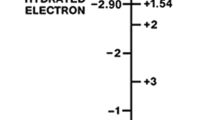Abstract
The concepts used conventionally in electrochemistry, single-ion chemical potential and electrostatic potential difference, are not obtainable from measurements in an inhomogeneous system. The use of nonoperational and mutually dependent forces in flux equations has impeded our understanding of electrochemical processes, and has led to wrong conclusions. The equation for entropy production is derived using only operationally defined quantities, chemical potentials of neutral components and the electric potential measured with reversible electrodes. The electric potential enters calculations as external electric work in the first law of thermodynamics. From entropy production, flux equations are obtained where the forces are operationally defined, measurable quantities. Three different problems from electrochemistry are discussed, the liquid junction potential, the Donnan potential, and energy coversion in mitochondria. The conventional method of calculations and the operational method are compared. The operational method permits more detailed calculations of emf, and an understanding of the process from a different approach.
Similar content being viewed by others
References
K. S. Førland, T. Førland, and S. K. Ratkje,Irreversible Thermodynamics, Theory and Applications (Wiley, Chichester, 1988).
K. S. Førland, T. Førland, and S. K. Ratkje, Transport processes in electrolytes and membranes inFlow, Diffusion and Rate Processes, S. Sieniutycz and P. Salamon, eds. (Taylor & Francis, New York, 1992).
K. S. Førland and T. Førland, The calculation of emf for cells with irreversible transport, inProceedings of the 5th Symposium on Ion-Selective Electrodes in Mátrafüred (Pergamon Press, Oxford, 1989), pp. 357–366.
L. Onsager, Reciprocal relations in irreversible processes, I,Phys. Rev. 37:405–426 (1931).
L. Onsager, Reciprocal relations in irreversible processes, II,Phys. Rev. 38:2265–2279 (1931).
D. G. Miller, Thermodynamics of irreversible processes,Chem. Rev. 60:15–37 (1960).
S. R. de Groot and P. Mazur,Non-Equilibrium Thermodynamics (North-Holland, Amsterdam, 1969), Chapter III, §3.
A. Katchalsky and P. F. Curran,Non-Equilibrium Thermodynamics in Biophysics (Harvard University Press, Cambridge, 1965), Chapter 7.3.
E. A. Guggenheim, The conceptions of electrical potential differences between two phases and the individual activities of ions,J. Phys. Chem. 33:842–849 (1929).
L. Onsager and R. M. Fuoss, Irreversible processes in electrolytes. Diffusion, conductance, and viscous flow in arbitrary mixtures of strong electrolytes,J. Phys. Chem. 36:2689–2778 (1932).
A. K. Covington, Recent developments in pH standardisation and measurement for dilute aqueous solutions,Anal. Chim. Acta 127:1–21 (1981).
A. W. Adamson,A Textbook in Physical Chemistry (Academic Press, New York, 1979), Chapter 13-ST-1.
E. E. Johnsen, S. K. Ratkje, T. Førland, and K. S. Førland, The liquid junction contribution to emf,Z. Phys. Chem. N. F. 169:101–114 (1990).
J. Breer, S. K. Ratkje, and G.-F. Olsen, Control of liquid junctions,Z. Phys. Chem. 174:179–198 (1991).
M. Alonso and E. J. Finn,Fundamental Physics, 2nd ed. (Addison-Wesley, Reading, Massachusetts, 1983), Vol. II, Chapter 2.9.
T. Førland, The diffusion process and the potential in relation to the emf of concentration cells,Acta Chem. Scand. 14:1381–1388 (1960).
T. Førland and S. K. Ratkje, Small contributions to emf from changes in electrostatic potentials,Electrochim. Acta 26:649–652 (1981).
T. Førland and T. Østvold, The Donnan potential. I,Acta Chem. Scand. A 28:607–611 (1974).
P. Mitchell, Coupling of phosphorylation to electron and hydrogen transfer by a chemiosmotic type mechanism,Nature 191:144–148 (1961).
T. Førland, S. K. Ratkje, and K. S. Førland, The phosphorylation process in mitochondria. Proton motive force and electric potential,Comments Mol. Cell. Biophys. 7:57–77 (1991).
H. Rottenberg and M. Gutman, Control of the rate of reverse electron transport in submitochondrial particles by the free energy,Biochemistry 16:3220–3227 (1977).
J. Sakamoto and Y. Tonomura, Synthesis of enzyme-bound ATP by mitochondrial soluble F1-ATPase in presence of dimethylsulphoxide,J. Biochem. 93:1601–1614 (1983).
Author information
Authors and Affiliations
Rights and permissions
About this article
Cite this article
Førland, K.S., Førland, T. An alternative approach to electrochemistry. J Stat Phys 78, 513–529 (1995). https://doi.org/10.1007/BF02183362
Received:
Accepted:
Issue Date:
DOI: https://doi.org/10.1007/BF02183362




